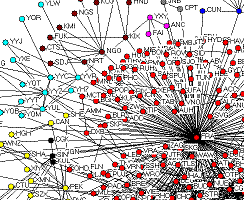Chinese domestic airline networks:: Difference between revisions
From Santa Fe Institute Events Wiki
No edit summary |
No edit summary |
||
| Line 7: | Line 7: | ||
[[Image:Lufthansa.gif]] | [[Image:Lufthansa.gif]] | ||
[http://web.mit.edu/gerganaa/ | [http://web.mit.edu/gerganaa/www/papers/ChineseAirlineNetworks.pdf Final Paper] | ||
[http://web.mit.edu/gerganaa/ | [http://web.mit.edu/gerganaa/www/papers/SupplementaryResults.pdf Supplementary Results] | ||
Latest revision as of 18:23, 11 July 2008
Abstract
We study the spatial form of the networks of the 20 largest domestic airlines by analyzing their edge set, degree and betweenness distributions, clustering coefficients and network diameter, and discover that the whole Chinese domestic airline network is not a scale-free but a small-world network. We analyze each network with two different metrics (i) fitness: we minimize the diameter of networks, and maximize the passenger flow for each edge; (ii) robustness: we compute the change in average path length after removing predetermined hubs and account for the scale of network disintegration. Finally, we compare the robustness of the network of different airlines and find that some small domestic airlines have very good robustness properties. Chinese airline topologies vary from pure stars to scale-free graphs to graphs with uniform dense clusters and scale-free branches to remote destinations.
Keywords: airline networks, topology, fitness, robustness

